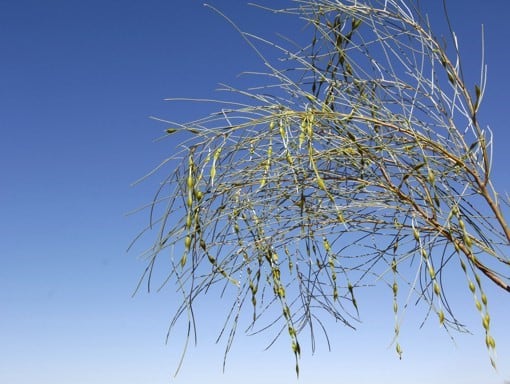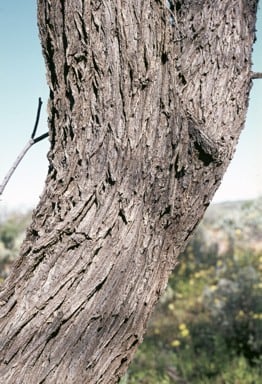Acacia sibilans Maslin
WATTLE
Acacias of Australia
Common Name
Whispering Myall
Family
Fabaceae
Distribution
Northwest W.A. mainly in the Gascoyne and upper Murchison districts where it extends from Shark Bay E to near Mileura Stn; there are disjunct occurrences in the Pilbara (c. 500 km north of Mileura) where it occurs on Roy Hill Stn and Ethel Creek Stn.
Description
Silvery spreading tree 3–7 (-12) m high; branches often slightly crooked, twisted and spreading ±horizontally. Bark fibrous, grey. Branchlets appressed-puberulous, glabrescent. Phyllodes ascending to erect, filiform, straight to shallowly curved to sinuous, terete, (8-) 10–18 cm long, 0.8–1 mm diam., with curved to uncinate apex, not rigid, silvery appressed-puberulous early but hairs confined to between nerves with age, finely multistriate. Inflorescences 2- or 3-headed racemes; raceme axes 0.5–1.5 mm long; peduncles 5–12 mm long, silvery appressed-puberulous; heads globular, 5 mm diam., 26–28-flowered, golden. Flowers 5‑merous; sepals free; petals pale yellow or silvery appressed-puberulous. Pods pendulous, moniliform, to 20 cm long, (3–) 7–10 mm wide, ±crustaceous, finely longitudinally nerved, hoary when young, ageing glabrescent except between seeds. Seeds longitudinal, compressed-elliptic, 9–12 mm long, dull, dark brown; aril small, pale yellow.
Phenology
Flowers erratically, possibly in response to heavy rains.
Habitat
Grows on plains and alluvial flats in shallow loam and sand over limestone, in low chenopodiaceous shrubland and, further inland, in Acacia shrubland.
Specimens
W.A.: 26.5 km N of Tropic of Capricorn beside North West Coastal Hwy, 28 Nov. 1983, W.Edgecombe (PERTH); c. 15 km S of Roy Hill Stn on Great Northern Hwy, B.R.Maslin 5271 (BRI, CANB, K, PERTH); Austin Downs Stn near Cue, A.A.Mitchell 902 (BRI, MEL, NY, PERTH).
Notes
An attractive, long-lived, but probably slow growing, tree with potential for amenity plantings.
Closely related to A. auripila. Also related to A. papyrocarpa, which has chartaceous, flat pods with smaller seeds, smaller flower-heads and generally shorter, straighter, subterete to flat phyllodes. Sometimes resembling A.coriacea and A. sericophylla which are readily distinguished by their united sepals, large, bright orange seed arils and normally flat, broader phyllodes.
A seemingly uncommon variant with narrow pods (3–5 mm wide) occurs near Giles Point in the Pilbara (e.g. E.Thoma 1443, PERTH) and in the Murchison/Ashburton district further south; it requires further study.
FOA Reference
Data derived from Flora of Australia Volumes 11A (2001), 11B (2001) and 12 (1998), products of ABRS, ©Commonwealth of Australia
Author
R.S.Cowan
This identification key and fact sheets are available as a mobile application:
URL: https://apps.lucidcentral.org/wattle/
© Copyright 2018. All rights reserved.













